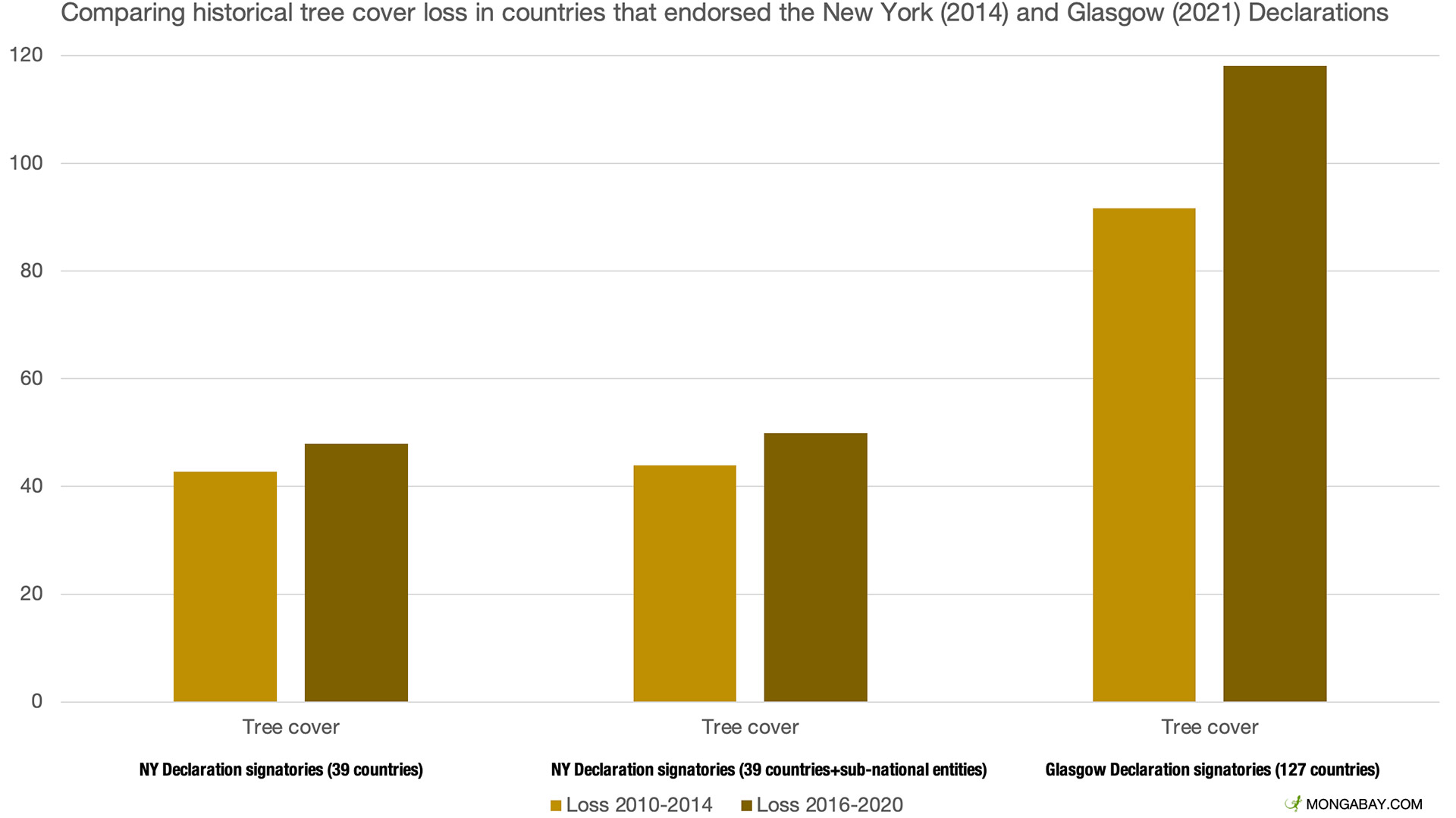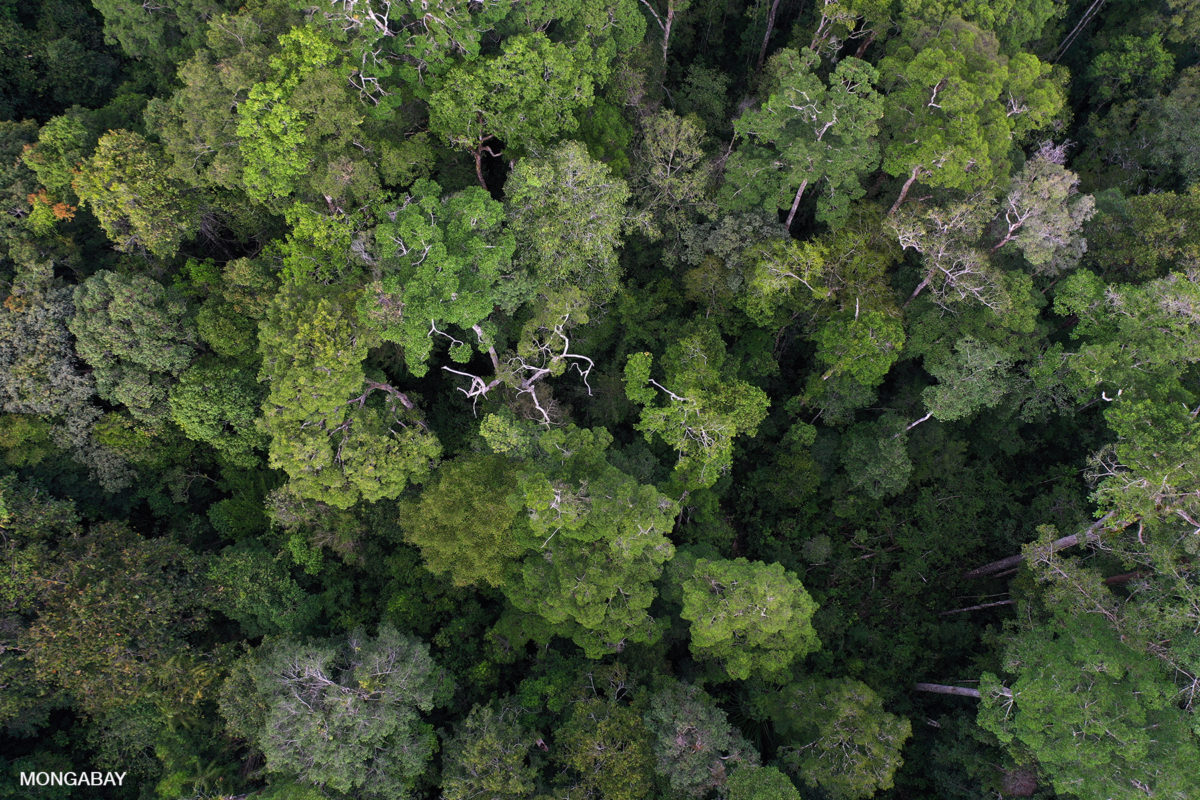On Tuesday, November 2, 2021, 127 countries signed the Glasgow Leaders’ Declaration on Forests and Land Use, pledging to “halt and reverse forest loss and land degradation” by 2030. The declaration, which was accompanied by some $19.2 billion in related funding commitments, was endorsed outside the United Nations Framework Convention on Climate Change (UNFCCC) process and is therefore legally non-binding.
The 127 signatories account for about 90% of global tree cover and 85% of the world’s primary tropical forests, including the nine top countries in terms of forest area. The Glasgow Declaration thus represents a much larger constituency than the 20 sub-national jurisdictions and 39 countries which signed the New York Declaration on Forests in 2014 and accounted for 39-44% tree cover and 39-55% of primary tropical forests.


Like the Glasgow Declaration, the New York Declaration was also a voluntary commitment, but it included a broader array of companies and NGOs. Yet the New York Declaration signatories missed badly in their collective ambition to halve deforestation by 2020 — tree cover loss in their territories rose by 13.8% from 43.9 million hectares (ha) between 2010-2014 to 49.9 million ha between 2016-2020, while primary tropical forest loss accelerated 19.3% from 7.1 million ha to 8.8 7.1 million ha.
Given the extent to which the New York Declaration failed to meet its near-term numeric target, it’s worth breaking down the aggregate data to look at countries on an individual basis to see where forest loss declined and increased.
Note that this analysis simply presents data — it does not evaluate why these developments unfolded the way they did in these countries. For that deeper assessment, there are many relevant articles across Mongabay.


About the data used in this analysis
The best available numbers on how forests have changed over the past decade on an annual basis by country comes from the dataset maintained by a team led by Matt Hansen of the University of Maryland and World Resources Institute’s Global Forest Watch. This data, which is published to Global Forest Watch each spring, doesn’t specifically include figures on deforestation. Instead it offers “tree cover loss” and “primary tropical forest loss”. Neither metric perfectly represents deforestation: Tree cover loss includes cyclical harvesting of plantations, die-off from pests and drought, and storm and fire damage; whereas primary forest loss includes natural disruptions and excludes the loss of secondary forests. Neither indicator captures reforestation, afforestation, and natural recovery of forests.
The U.N. Food and Agriculture Organization (FAO) releases deforestation data every five years, but much of this is self-reported by governments, which leads to significant inconsistencies, like countries that report increasing primary forest cover, ignore forest cover change that occurs outside arbitrarily determined forest areas, or simply don’t report natural forest loss if that area will eventually be replanted with trees or crops.
Therefore this analysis will rely on the Global Forest Watch/Hansen data that was released in March 2021. Given that the New York Declaration on Forests was signed in September 2014, the baseline is the aggregate loss of primary tropical forest or tree cover that occurred between 2010 and 2014. Since the 2020 target of the declaration was to halve deforestation, 2016-2020 is used as the period of comparison.

Countries that had the biggest drop in primary tropical forest loss
Primary tropical forests are among the world’s most carbon-dense and biologically diverse forests. Accordingly, their decline has significant implications for both climate change and species extinction. Primary tropical forests are therefore central to efforts to arrest deforestation.
Indonesia, which signed both the 2014 New York Declaration and the 2021 Glasgow Declaration experienced the biggest decline in primary tropical forest loss, with its loss failing 31% — nearly a million ha — from 3.22 million hectares to 2.24 million hectares. No signatory country came even remotely close to Indonesia. The only countries that saw a decline of more than 30,000 ha were Argentina (-52% or 77,000 ha), Côte d’Ivoire (-30% or 37,500 ha), and Vietnam (-15% or 36,000 ha).
In percentage terms, both China (-65%) and Thailand (-55%) experienced substantial drops in the extent of primary forest loss, albeit off low baselines.


Countries that had the biggest increase in primary tropical forest loss
Many more countries experienced increases in their primary tropical forest loss between the two periods.
Brazil, which did not endorse the New York Declaration but did sign Glasgow, saw its primary forest loss more than double from 4.65 million ha to 9.4 million ha. Most of that loss occurred in the Amazon rainforest, where the deforestation rate has been on an upward trend since 2012.
Democratic Republic of the Congo (DRC), which ranks second in terms of tropical forest cover and signed both declarations, has the second highest increase, with primary forest loss rising 71% from 1.42 million ha to 2.42 million ha. Colombia (+109% or 380,000 ha), Peru (+27% or 173,000 hectares), Cameroon (+83% or 163,000 ha), and Mexico (+95% or 139,000 hectares) followed. Of these five countries, only Cameroon wasn’t party to the New York Declaration.
In percentage terms, of signatories with more than 500,000 ha of primary tropical forest, Costa Rica had the biggest increase at 199%. Liberia (+125%) and Colombia (+109%) were the only other countries to see their rate more than double.

Countries that saw the biggest drop in tree cover loss
As noted above, tree cover loss isn’t always a good proxy for deforestation, especially in countries where there are extensive industrial forestry operations in plantations, large incidence of forest fires, and pest-induced forest die-offs like Russia, Canada, and the United States. So the data presented below doesn’t necessarily reflect deforestation, though these changes in land use do have implications for carbon emissions.
Canada experienced the biggest decline in the extent of tree cover loss, with the area of loss falling from 12.26 million hectares between 2010 and 2014 to 10.16 million hectares, a drop of 2.1 million hectares or 17%. Nonetheless, the country had the greatest tree cover loss of any signatory during the former period, and the second largest loss during the latter period.
Indonesia — which again signed both declarations — ranked second with a decline of 1.04 million hectares (13%), followed by Argentina with a decline of 1.03 million hectares (51%). Argentina signed the Glasgow Declaration, but not New York.


Countries that saw the biggest rise in tree cover loss
At the other end of the spectrum, the countries that saw the greatest increase in tree cover loss were Brazil (6.67 million ha), Russia (5.3 million ha), Australia (3.84 million ha), DRC (2.62 million ha), and the United States (1.48 million ha). Of these five, Russia, Australia, and the U.S. are experiencing a rise in the incidence of fire, while deforestation has risen sharply in DRC and Brazil.
Australia led the world in percentage terms with a 351% rise, much of which is likely attributable to increasing incidence of fire.
Among the sub-national jurisdictions that signed the New York Declaration, the U.S. state of California stood out for its 231% increase in tree cover loss. California is also experiencing an increase in forest fires.

What does it all mean?
While it’s beyond the scope of this quick exercise to determine the impact of signing either the New York Declaration or the Glasgow Declaration on behavior and policies in individual countries, it is interesting to compare the trends in tree cover loss and primary tropical forest loss across signatories and non-signatories.
Tropical primary forest loss rose 43% from 15.9 million ha to 22.7 million ha between the five-year period leading up to the New York Declaration (2010-2014) and five-year period around the target year for halving deforestation (2016-2020). Tree cover loss rose 29% from 104 million ha to 133.8 million ha.
By comparison, the countries and sub-national jurisdictions that signed the New York Declaration experienced a 19.3% increase in primary tropical forest loss and 13.8% increase in tree cover loss respectively — significantly better than the global average, but still far short of the target “halving” by 2020.
At 50% and 29% respectively, the Glasgow signatories as a whole were closer to the worldwide averages. It’s worth noting that several countries with high rates of forest loss have not yet signed the Glasgow Declaration, including Malaysia (which lost 1.6 million ha of primary forests over the past decade), Cambodia (840,000 ha), Laos (5579,000 ha), Paraguay (518,000), and Myanmar (387,000 ha).

No matter how one cuts the data, it’s clear that to “halt and reverse forest loss and land degradation” by 2030, very substantial progress needs to be made in reducing primary tropical forest loss (3.1 million ha per year over the past decade) and tree cover loss (23.9 million ha per year). Countries plan to partly achieve this goal by “offsetting” losses through reforestation and afforestation, but replacing native ecosystems with tree plantations won’t help climate, environmental services, and wildlife as much as avoiding conversion in the first place.
Indeed, policies that prioritize “zero net deforestation” at the expense of natural forests will undermine the very goals that these declarations claim to aspire to achieve.

